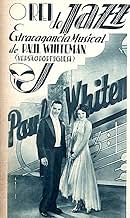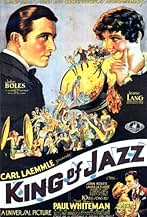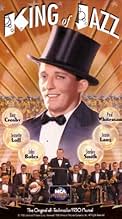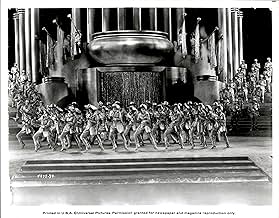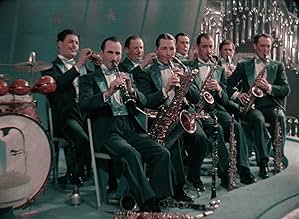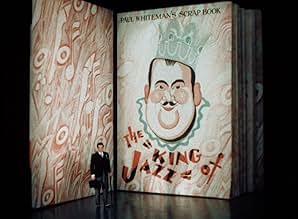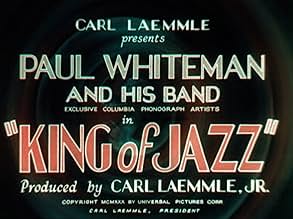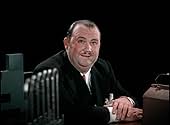AVALIAÇÃO DA IMDb
6,7/10
1,8 mil
SUA AVALIAÇÃO
Adicionar um enredo no seu idiomaA rotund bandleader leads a series of theatrical sketches, dance numbers, special effects, and animated segments.A rotund bandleader leads a series of theatrical sketches, dance numbers, special effects, and animated segments.A rotund bandleader leads a series of theatrical sketches, dance numbers, special effects, and animated segments.
- Direção
- Roteiristas
- Artistas
- Ganhou 1 Oscar
- 4 vitórias no total
Harry Barris
- One of the Rhythm Boys
- (as The Rhythm Boys)
Bing Crosby
- One of the Rhythm Boys
- (as The Rhythm Boys)
Al Rinker
- One of the Rhythm Boys
- (as The Rhythm Boys)
Carla Laemmle
- Chorine
- (as Beth Laemmle)
- Direção
- Roteiristas
- Elenco e equipe completos
- Produção, bilheteria e muito mais no IMDbPro
Avaliações em destaque
"King Of Jazz" is a museum piece. Let's face it, anyone under 50 probably never heard of Paul Whiteman, and anyone under 40 only knows Bing Crosby from his Christmas album. That leaves the rest of us.
For The Rest Of Us, it doesn't get any better than "King Of Jazz". That, of course, was Paul Whiteman, rotund band leader of a bygone era who is the nominal star of this film. He was not an actor, and so the film is given over to actors and other entertainers. The accent here is on 'entertainer', as this movie is festooned with lots and lots of them.
Ever see Bing Crosby with his real hair? Ever see the Radio City Rockettes, thunder-thighed in the late 20's? Ever see George Gershwin in a movie? How about vaudevillian Al Norman with his rubber-legged dancing? It's all here, in a non-stop revue of old and almost-forgotten songs and dance numbers (there are 18 in all), interspersed with blackouts and comedy skits. Plus, it's in color (sort of) - actually, it's primitive 2 strip color.
I could go on and on but if you are a hard-core movie fan or a film historian, "King Of Jazz" is for you. The jokes are stale, the singers still trilled their 'R's, and the gowns in the bridal number are so out of style they are probably coming back. The overall effect was both sheer delight and visually overwhelming and I wished it would never end. It is available only on VHS and hasn't been seen on TV in years. It is a must for The Rest Of Us.
P.S. Ever see Paul Whiteman tap dance?
For The Rest Of Us, it doesn't get any better than "King Of Jazz". That, of course, was Paul Whiteman, rotund band leader of a bygone era who is the nominal star of this film. He was not an actor, and so the film is given over to actors and other entertainers. The accent here is on 'entertainer', as this movie is festooned with lots and lots of them.
Ever see Bing Crosby with his real hair? Ever see the Radio City Rockettes, thunder-thighed in the late 20's? Ever see George Gershwin in a movie? How about vaudevillian Al Norman with his rubber-legged dancing? It's all here, in a non-stop revue of old and almost-forgotten songs and dance numbers (there are 18 in all), interspersed with blackouts and comedy skits. Plus, it's in color (sort of) - actually, it's primitive 2 strip color.
I could go on and on but if you are a hard-core movie fan or a film historian, "King Of Jazz" is for you. The jokes are stale, the singers still trilled their 'R's, and the gowns in the bridal number are so out of style they are probably coming back. The overall effect was both sheer delight and visually overwhelming and I wished it would never end. It is available only on VHS and hasn't been seen on TV in years. It is a must for The Rest Of Us.
P.S. Ever see Paul Whiteman tap dance?
Universal spent over a year making this movie -- Paul Whiteman's band set forth for Hollywood on a chartered train called the "Old Gold Special" in January 1929 (Old Gold Cigarettes sponsored his CBS radio program) and arrived, ready to work, only to find that no one at Universal had bothered to come up with a script. Seven months later he headed himself and his band back to New York after telling the "suits" at Universal he wasn't coming back until there was a finished script and the film was ready to shoot. During the stand-down Whiteman lost the best musician he ever had, Bix Beiderbecke, to Bix's chronic alcoholism, and Universal lost the originally assigned director, Paul Fejos, when he had a nervous breakdown while shooting another film. By the time Whiteman returned, the Great Depression had hit, the Zeitgeist had changed and the American people weren't in the mood for lavish musicals anymore. So "King of Jazz" became a legendary box-office flop.
It's a fate the movie didn't deserve: though there are a few scenes in which director John Murray Anderson falls back on the typical long-shots of chorus lines that make them look like ants on a wedding cake, for the most part his direction is vividly imaginative, fully the equal of what Busby Berkeley was doing on his first film, "Whoopee," another all-color musical being filmed at the same time. Anderson gives us numbers from overhead, from side angles, and uses the swooping camera movements of the so-called "'Broadway' Crane" (invented by cinematographer Hal Mohr and director Paul Fejos for Universal's 1929 film of the hit musical "Broadway") to deliver dazzling images and splendors to delight the eye and avoid the static quality of many of the early musicals. Anderson had come to Hollywood from his experience directing most of the Ziegfeld Follies on stage and running an acting school that trained Bette Davis and Lucille Ball, and for this film he was given virtually unprecedented authority. "King of Jazz" should have been his ticket to a major film career, but instead after its failure he retreated to the stage and only worked on two more films, the 1944 Esther Williams vehicle "Bathing Beauty" (for which he staged the incredible final number, often misattributed to Berkeley!) and Cecil B. DeMille's circus drama "The Greatest Show on Earth" (1953). It's a crime against culture that Anderson wasn't given the job of directing "The Great Ziegfeld" (1936), since he knew Ziegfeld's style (indeed, had helped create it) and he knew how to make a movie; an Anderson-directed "Great Ziegfeld" could have been a masterpiece instead of the ponderous bore (redeemed only by the acting of William Powell and Myrna Loy) MGM and hack director Robert Z. Leonard actually gave us.
"King of Jazz" was one of the handful of revues (a Broadway term for a musical with no plot) filmed in 1929 and 1930, including MGM's "Hollywood Revue of 1929," Warner Bros.' "The Show of Shows," Fox's "Fox Movietone Follies of 1929," and Paramount's "Paramount on Parade." (There was also a British version, "Elstree Calling," in which the framing scenes showing actor Gordon Harker tuning in variety performers on an early TV were directed by Alfred Hitchcock, who didn't think the assignment was important enough to put the film on his official résumé.) But "King of Jazz" is better than all of them, even though Universal's list of contract players was far less illustrious than those of their major-studio competitors (the biggest "names" in this movie who weren't part of Whiteman's organization were Laura LaPlante and John Boles). It helps that the comedy scenes between the big musical numbers are kept to a minimum, and are short, genuinely funny and surprisingly racy for a 1930 film. The only thing that badly dates this movie (and led me to rate it 9 instead of 10) are the unfunny and badly dated novelty songs, including "Oh, How I'd Love to Own a Fish Store," "Has Anybody Here Seen Nellie?" and Wilbur Hall's performance of "Stars and Stripes Forever" on a bicycle pump.
"King of Jazz" is a towering musical masterpiece, rivaled only by "Whoopee" at the top of the heap for pre-"42nd Street" musicals. (The Lubitsch and Mamoulian films for Maurice Chevalier and Jeanette MacDonald are in a separate category altogether.) The film is a tribute to the genius of its director, John Murray Anderson, though the one Academy Award it won was for its art director, Herman Rosse, probably the first individual ever to win an Oscar for an all-color film. "King of Jazz" is a music that will dazzle you with spectacular moment after spectacular moment, including the "Rhapsody in Blue" sequence that, along with the "New York Rhapsody" sequence in the 1931 film "Delicious," does more justice to George Gershwin's music than any sequence using it until the 1951 ballet in "An American in Paris."
It's a fate the movie didn't deserve: though there are a few scenes in which director John Murray Anderson falls back on the typical long-shots of chorus lines that make them look like ants on a wedding cake, for the most part his direction is vividly imaginative, fully the equal of what Busby Berkeley was doing on his first film, "Whoopee," another all-color musical being filmed at the same time. Anderson gives us numbers from overhead, from side angles, and uses the swooping camera movements of the so-called "'Broadway' Crane" (invented by cinematographer Hal Mohr and director Paul Fejos for Universal's 1929 film of the hit musical "Broadway") to deliver dazzling images and splendors to delight the eye and avoid the static quality of many of the early musicals. Anderson had come to Hollywood from his experience directing most of the Ziegfeld Follies on stage and running an acting school that trained Bette Davis and Lucille Ball, and for this film he was given virtually unprecedented authority. "King of Jazz" should have been his ticket to a major film career, but instead after its failure he retreated to the stage and only worked on two more films, the 1944 Esther Williams vehicle "Bathing Beauty" (for which he staged the incredible final number, often misattributed to Berkeley!) and Cecil B. DeMille's circus drama "The Greatest Show on Earth" (1953). It's a crime against culture that Anderson wasn't given the job of directing "The Great Ziegfeld" (1936), since he knew Ziegfeld's style (indeed, had helped create it) and he knew how to make a movie; an Anderson-directed "Great Ziegfeld" could have been a masterpiece instead of the ponderous bore (redeemed only by the acting of William Powell and Myrna Loy) MGM and hack director Robert Z. Leonard actually gave us.
"King of Jazz" was one of the handful of revues (a Broadway term for a musical with no plot) filmed in 1929 and 1930, including MGM's "Hollywood Revue of 1929," Warner Bros.' "The Show of Shows," Fox's "Fox Movietone Follies of 1929," and Paramount's "Paramount on Parade." (There was also a British version, "Elstree Calling," in which the framing scenes showing actor Gordon Harker tuning in variety performers on an early TV were directed by Alfred Hitchcock, who didn't think the assignment was important enough to put the film on his official résumé.) But "King of Jazz" is better than all of them, even though Universal's list of contract players was far less illustrious than those of their major-studio competitors (the biggest "names" in this movie who weren't part of Whiteman's organization were Laura LaPlante and John Boles). It helps that the comedy scenes between the big musical numbers are kept to a minimum, and are short, genuinely funny and surprisingly racy for a 1930 film. The only thing that badly dates this movie (and led me to rate it 9 instead of 10) are the unfunny and badly dated novelty songs, including "Oh, How I'd Love to Own a Fish Store," "Has Anybody Here Seen Nellie?" and Wilbur Hall's performance of "Stars and Stripes Forever" on a bicycle pump.
"King of Jazz" is a towering musical masterpiece, rivaled only by "Whoopee" at the top of the heap for pre-"42nd Street" musicals. (The Lubitsch and Mamoulian films for Maurice Chevalier and Jeanette MacDonald are in a separate category altogether.) The film is a tribute to the genius of its director, John Murray Anderson, though the one Academy Award it won was for its art director, Herman Rosse, probably the first individual ever to win an Oscar for an all-color film. "King of Jazz" is a music that will dazzle you with spectacular moment after spectacular moment, including the "Rhapsody in Blue" sequence that, along with the "New York Rhapsody" sequence in the 1931 film "Delicious," does more justice to George Gershwin's music than any sequence using it until the 1951 ballet in "An American in Paris."
This has an animation and in-camera tricks introduction. The main body is a big musical presenting band leader Paul Whiteman as The King of Jazz. It's an early musical a few years after the introduction of sound. It's a series of musical numbers on a big stage setting. It's a large production but there is no overarching connecting plot. The main connecting device is a giant book that is flipped to get to the next chapter. It's also in Technicolor. There are comedic interstitial scenes. As a historical document, it is absolutely fascinating. It's almost Vaudeville on film in that it's just a lot of performers performing on stage. It is a movie of a bygone era. It's also the first film with Bing Crosby. It was a bit of a failure at the time which may be due to a flood of similar musicals. It's a scattershot of lavish musical scenes without much connective tissue. By the midway point, any novelty is worn out as it all becomes more and more of the same fascinating nothingness. It has no story and it's not concentrating on any single character other than Paul Whiteman who is mostly simply a face. This may not be a great film but it is a fascinating one.
Today's audiences could not possibly have any idea of how big in every way Paul Whiteman was during the 1920s. Radio was in its infancy and Paul Whiteman's band was the first orchestra to achieve popularity through that medium. Whiteman records were the biggest sellers of their time. And The King of Jazz was his auspicious debut in motion pictures.
The King of Jazz was also how Whiteman billed himself. He was maybe taking a bit much on to himself with that one, he surely didn't have anything to do with the development of jazz as an art form. But he did help a great deal to popularize it with a wider {white} audience. That was primarily done with that famous jazz concert that Whiteman gave in the mid twenties where George Gershwin's Rhapsody In Blue made its debut. And Rhapsody is reprised here in the movie.
Whiteman's greatest contribution may have been the training of the greatest group of musicians ever. At one time or other, the Dorsey Brothers, Benny Goodman, Bix Biederbecke and so many others were members of the Whiteman orchestra. And of course he was the very first band to hire a vocalist specifically for that role. Previously singers were just musicians who just stopped playing and sang a chorus or two.
Whiteman hired a trio, the Rhythm Boys whose lead singer was Bing Crosby. They are prominent in the film and in fact Bing Crosby made his singing film debut here over the opening credits as he sang Music Hath Charms. He was Whiteman's biggest discovery.
The film is just a musical review done in the style of some of the great musical reviews of the time like the Ziegfeld Follies, Earl Carroll's Vanities, George White's Scandals. Some of the acts are better than others, but's The King of Jazz encapsulates a great era in show business.
The biggest song from the film was It Happened in Monterey sung by John Boles who was Universal's biggest musical star at that point. Boles also got to do the film's finale, The Song of the Dawn, when Crosby who was guzzling a little too much bathtub gin got himself arrested and missed doing the finale which he was scheduled for.
Shortly after recording some of the songs from The King of Jazz the Rhythm Boys left Whiteman and broke up soon after that. Bing Crosby would be heard from again.
For a wonderful piece of nostalgia and filmed in early technicolor at that as an added treat, you can't beat The King of Jazz.
The King of Jazz was also how Whiteman billed himself. He was maybe taking a bit much on to himself with that one, he surely didn't have anything to do with the development of jazz as an art form. But he did help a great deal to popularize it with a wider {white} audience. That was primarily done with that famous jazz concert that Whiteman gave in the mid twenties where George Gershwin's Rhapsody In Blue made its debut. And Rhapsody is reprised here in the movie.
Whiteman's greatest contribution may have been the training of the greatest group of musicians ever. At one time or other, the Dorsey Brothers, Benny Goodman, Bix Biederbecke and so many others were members of the Whiteman orchestra. And of course he was the very first band to hire a vocalist specifically for that role. Previously singers were just musicians who just stopped playing and sang a chorus or two.
Whiteman hired a trio, the Rhythm Boys whose lead singer was Bing Crosby. They are prominent in the film and in fact Bing Crosby made his singing film debut here over the opening credits as he sang Music Hath Charms. He was Whiteman's biggest discovery.
The film is just a musical review done in the style of some of the great musical reviews of the time like the Ziegfeld Follies, Earl Carroll's Vanities, George White's Scandals. Some of the acts are better than others, but's The King of Jazz encapsulates a great era in show business.
The biggest song from the film was It Happened in Monterey sung by John Boles who was Universal's biggest musical star at that point. Boles also got to do the film's finale, The Song of the Dawn, when Crosby who was guzzling a little too much bathtub gin got himself arrested and missed doing the finale which he was scheduled for.
Shortly after recording some of the songs from The King of Jazz the Rhythm Boys left Whiteman and broke up soon after that. Bing Crosby would be heard from again.
For a wonderful piece of nostalgia and filmed in early technicolor at that as an added treat, you can't beat The King of Jazz.
"The King Of Jazz" 1930, is a wonderful example of just what the movies could do in the late 20's early 30's if they put their mind to it. The technical achievement is extremely high, for a film of this period, and one wonders at how cinema audiences of 1930 must have been amazed by this picture. It is photographed in a system called "Two Strip Technicolor". (Full 3-strip Technicolor would not be invented until 1932). The 2-strip Technicolor system managed to capture Red and Green, but not blue. To get around this they would use dyes that were a kind of orange/red and aqua-marine/green to trick audiences into thinking there was blue on screen.
In this movie the "Rhapsody in Blue" number is very convincing.
There is no plot to "The King Of Jazz", it is just one mammoth musical number after another, and that adds to its unique charm. My three favourite numbers are "Ragamuffin Romeo", "It Happened In Monterey", and "My Bridal Veil".
The "Bridal Veil" number utilizes one of the biggest indoor sets I have ever seen. A lot of money was spent on this picture, and it shows. The Bridal Veil itself looks to be about 100 feet long and the bride needs about 40 bridesmaids to help hold it up.
The print that is currently in circulation of "The King Of Jazz" is sadly not in 100% excellent condition. It seems to be made up of pristine sections of print, and battered and scratched dupes. Its a real patchwork version that is probably in need of some restoration work. The title sequence, (with vocals over the titles by Bing Crosby singing "Music Hath Charms") is very clear and in good shape, but then halfway through cuts to an extremely battered dupe copy? The same occurrence happens during the "It Happened In Monterey" number, and also "Bench In The Park", we are given a beautiful print with rich colours and rock steady picture stability, only to cut variously to scratched beaten dupes. I cannot understand why certain sections of the film were preserved but others were not.
I am eagerly awaiting the DVD release of this unique and wonderful film and hope it wont be too long before it gets its well deserved release. There don't seem to be any plans as yet and the only way to see this movie is on television or VHS. This is a true lost opportunity to DVD producers because the film has many wonderful Bing Crosby numbers in it and would be very popular with Bing's fans.
In this movie the "Rhapsody in Blue" number is very convincing.
There is no plot to "The King Of Jazz", it is just one mammoth musical number after another, and that adds to its unique charm. My three favourite numbers are "Ragamuffin Romeo", "It Happened In Monterey", and "My Bridal Veil".
The "Bridal Veil" number utilizes one of the biggest indoor sets I have ever seen. A lot of money was spent on this picture, and it shows. The Bridal Veil itself looks to be about 100 feet long and the bride needs about 40 bridesmaids to help hold it up.
The print that is currently in circulation of "The King Of Jazz" is sadly not in 100% excellent condition. It seems to be made up of pristine sections of print, and battered and scratched dupes. Its a real patchwork version that is probably in need of some restoration work. The title sequence, (with vocals over the titles by Bing Crosby singing "Music Hath Charms") is very clear and in good shape, but then halfway through cuts to an extremely battered dupe copy? The same occurrence happens during the "It Happened In Monterey" number, and also "Bench In The Park", we are given a beautiful print with rich colours and rock steady picture stability, only to cut variously to scratched beaten dupes. I cannot understand why certain sections of the film were preserved but others were not.
I am eagerly awaiting the DVD release of this unique and wonderful film and hope it wont be too long before it gets its well deserved release. There don't seem to be any plans as yet and the only way to see this movie is on television or VHS. This is a true lost opportunity to DVD producers because the film has many wonderful Bing Crosby numbers in it and would be very popular with Bing's fans.
Você sabia?
- CuriosidadesThe animation sequence, created by Walter Lantz, was the first Technicolor animation ever produced.
- Erros de gravaçãoIn the introduction to ''Ladies of the Press" Grace Hayes is listed as 'Third Reporter' and Kathryn Crawford is listed as 'Fourth Reporter'. This is the reverse of the actual case. Grace Hayes is easily recognizable as the 'Rough Wife' in "Do Things for You". She is the fourth and final reporter in the skit.
- Citações
Announcer: You don't mean to tell me that you are well-versed in the intricacies of the art of Terpsichore?
Paul Whiteman: No, but I can dance.
- Versões alternativasRestored in 2016 with a running time of 99 minutes. This version replicates the scene continuity of the 1930 release version, including about a minute of exit music. A small amount of footage was not found and is covered by still photographs. This is the version that played at the Museum of Modern Art and Film Forum in 2016, and was released by the Criterion Collection on Blu-ray and DVD in 2018.
- ConexõesFeatured in The All Talking, All Singing, All Dancing Show (1973)
- Trilhas sonorasRhapsody in Blue
(uncredited)
Music by George Gershwin
Played briefly during the opening credits
Played by Paul Whiteman and Orchestra (as "The Paul Whiteman Orchestra") during the production number
Performed by Roy Bargy (piano)
Danced by Jacques Cartier with clarinet, along with the Russell Markert Girls and The Sisters G
Principais escolhas
Faça login para avaliar e ver a lista de recomendações personalizadas
- How long is King of Jazz?Fornecido pela Alexa
Detalhes
- Data de lançamento
- País de origem
- Idiomas
- Também conhecido como
- O Rei do Jazz
- Locações de filme
- Empresa de produção
- Consulte mais créditos da empresa na IMDbPro
Bilheteria
- Orçamento
- US$ 2.000.000 (estimativa)
- Tempo de duração1 hora 39 minutos
Contribua para esta página
Sugerir uma alteração ou adicionar conteúdo ausente


